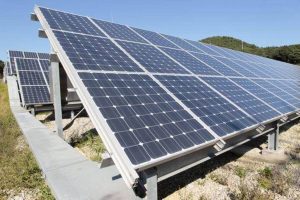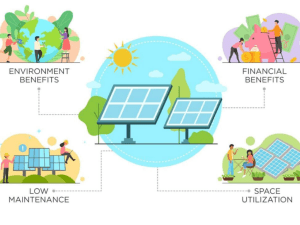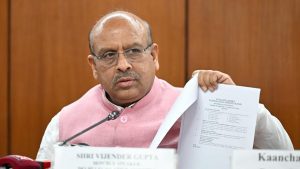New Delhi – A major push for sustainable energy is underway in the heart of India’s capital. Delhi Assembly Speaker Vijender Gupta has announced the installation of a solar energy system on Assembly premises, including a 500 KW solar power plant. The project is scheduled to be completed within 100 days and is expected to generate substantial savings — nearly ₹15 lakh per month — in electricity bills for the Assembly.
This marks another significant stride in Delhi’s renewable energy agenda and demonstrates how public institutions can lead by example. Below, we detail the vision, benefits, technology, cost-effectiveness, implementation strategy, and long-term impact of this high-impact project.
The Vision: A Solar-Powered Legislature

The plan to install a solar energy system on Assembly premises was announced as part of a broader initiative to make Delhi’s key government buildings more energy efficient and environmentally friendly. Speaker Vijender Gupta emphasized that sustainability is no longer optional — it’s a responsibility. He stated that the Delhi Assembly should serve as a model for adopting renewable solutions in governance infrastructure.
The Assembly building, located in the heart of Delhi, operates year-round with considerable power consumption. Shifting to clean energy will not only reduce dependence on the grid but also significantly lower recurring costs.
The solar energy system on Assembly premises is projected to be self-sustaining and will use rooftop and parking area spaces for installation, maximizing solar panel coverage.
Technical Specifications of the Solar Energy System
The project includes a 500-kilowatt solar plant that will be installed through a turnkey solar engineering, procurement, and construction (EPC) contract. Key highlights include:
-
Capacity: 500 KW
-
Type: Grid-connected rooftop solar system
-
Coverage Area: Rooftop, terrace, and parking shelters
-
Expected Output: ~75,000 units per month
-
Monthly Savings: ₹15 lakh
-
Annual Reduction in Carbon Emissions: 450 tons
The solar energy system will be linked to the Delhi power grid and will use net metering to track electricity generation and consumption.
With the solar energy system on Assembly premises, real-time monitoring will be enabled via a centralized control system, allowing administrators to track power production, usage patterns, and overall efficiency.
Project Timeline and Implementation
Speaker Vijender Gupta outlined a concrete 100-day roadmap. The timeline for the solar energy system on Assembly premises includes:
-
Week 1–2: Final vendor selection and EPC contract signing
-
Week 3–4: Site assessment, design approval, and equipment procurement
-
Week 5–10: Installation of support structures and panels
-
Week 11–13: Wiring, inverter setup, and grid synchronization
-
Week 14: Final inspection, testing, and commissioning
This well-planned timeline ensures that the solar energy system will begin contributing to Delhi’s power needs within three months.
The Cost Advantage: A ₹15 Lakh Monthly Saving


Perhaps the most eye-catching element of this initiative is the financial saving. Current electricity bills for the Assembly complex run as high as ₹20–22 lakh per month, depending on seasonal variations.
Once the solar energy system on Assembly premises becomes operational, projections estimate that 65–75% of power requirements will be met through solar energy. This translates to monthly savings of ₹15 lakh and annual savings of ₹1.8 crore.
The payback period for the entire setup is expected to be under 4 years, after which the system will continue to deliver cost-free energy for another 20+ years.
Strategic Sustainability and Eco Benefits
Installing a solar energy system on Assembly premises isn’t just about saving money — it’s about reducing the environmental footprint of one of Delhi’s most important institutions. Here are the environmental gains:
-
Carbon Offset: 450 tons of CO2 emissions will be reduced annually — equivalent to planting over 7,000 trees.
-
Air Quality Improvement: Less reliance on coal-powered energy will contribute to reduced air pollution.
-
Climate Leadership: Encourages similar adoption in schools, hospitals, courts, and public buildings.
Delhi, which faces serious pollution issues, can set an example by integrating clean energy into legislative operations through the solar energy system on Assembly premises.
Long-Term Vision: Scaling Beyond the Assembly
While this 500 KW installation is a landmark project, officials have hinted at future plans to expand solar infrastructure across all key government buildings in Delhi. The Delhi Secretariat, public libraries, and administrative departments are potential candidates for the next phase.
A successful implementation of the solar energy system on Assembly premises could trigger a city-wide strategy to achieve 25% solar-powered government operations by 2030.
Maintenance and Monitoring Plans
Post-installation, the vendor will provide 5 years of free operations and maintenance (O&M) services. The Assembly’s electrical engineering department will also receive training on handling minor technical issues and interpreting data from the solar dashboards.
Daily production logs, inverter status, and fault reports from the solar energy system on Assembly premises will be displayed on an LED panel at the entrance to educate visitors and stakeholders.
Role of Public Participation and Awareness
Officials plan to use this project as an educational opportunity. School children and college students will be invited for guided tours of the solar energy system on Assembly premises once it is operational.
Additionally, an awareness campaign across social media platforms will be launched to promote clean energy adoption. Informational videos, explainer posters, and behind-the-scenes installation footage will be shared.
This move aims to create a ripple effect among citizens to adopt rooftop solar solutions for their homes and businesses.
Policy Context: How This Aligns with National Solar Goals?
India aims to generate 280 GW of solar power by 2030. The decision to install a solar energy system on Assembly premises aligns with this national goal and sends a strong message of leadership from the capital.
Delhi itself has set a target of sourcing 25% of its electricity from renewable sources by 2027. This project is a critical step in that direction.
Challenges and Risk Mitigation
Like any infrastructure project, installing the solar energy system on Assembly premises comes with its challenges. These include:
-
Monsoon-Related Delays: Rain could hamper installation work
-
Equipment Procurement Delays: Supply chain disruptions may affect timelines
-
Grid Synchronization Issues: Technical alignment with DISCOM guidelines must be managed carefully
Mitigation plans include buffer time in the schedule, multiple suppliers for key components, and early engagement with power distribution companies for approvals.
Support from Lawmakers and Civil Society


Members of the Legislative Assembly have expressed overwhelming support for this initiative. Several MLAs have suggested replicating the solar energy system on Assembly premises in their constituency offices.
Civil society organizations working in the renewable energy space have also welcomed the announcement, calling it a “milestone moment” in Delhi’s green transition.
Final Thoughts: A Model for the Future
As the world faces mounting energy and environmental challenges, Delhi’s initiative to install a solar energy system on Assembly premises showcases proactive leadership and climate responsibility. The project represents not just cost-saving and efficiency, but also a philosophical shift towards cleaner, smarter governance.
It is a forward-looking solution that could well inspire similar transformations across the country.

